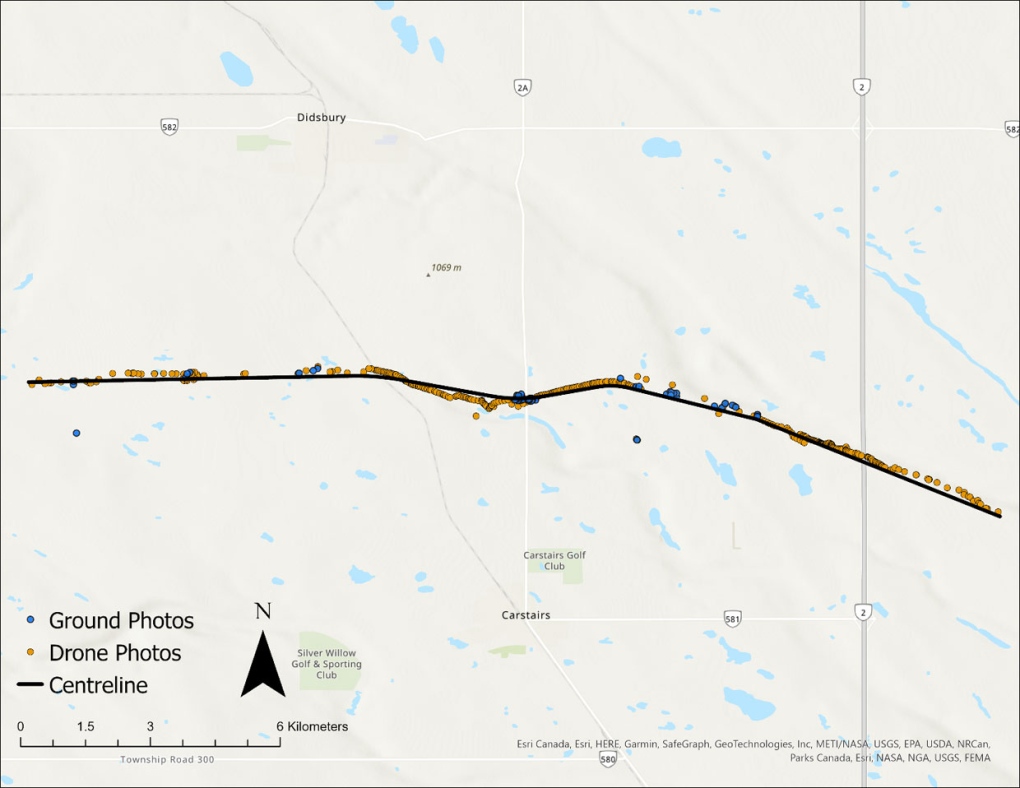Alberta's Canada Day tornado given EF4 rating
A team of experts has classified a tornado that tore a path of destruction near Carstairs, Alta., on Canada Day an EF4.
The Northern Tornadoes Project (NTP), in collaboration with Environment and Climate Change Canada's (ECCC) Prairie and Arctic Storm Prediction Centre, made the determination Tuesday following an analysis of the damage left behind.
"The survey teams found that there was enough evidence to rate the tornado damage at EF4, with a maximum wind speed of 275 km/h," NTP said in a statement.
"The preliminary path length is 15.3 kilometres and maximum path width 620 metres."
Officials say 12 homes were impacted by the storm: three were destroyed, four were left uninhabitable and five others were damaged.
WHAT IS THE EF SCALE?
According to ECC, the EF (Enhanced Fujita) Scale is a six-point scale that ranges from zero (weakest) to five (strongest). It was adopted in April 2013 as "a more modern and improved version of the original Fujita Scale or F Scale.
"Environment Canada used the F-Scale to rate wind damage, in particular tornado damage, for several decades. However, the F-Scale, developed by Prof. T. Fujita in the 1960s, was found to have significant shortcomings. There was a limited number of damage indicators with which to rate damage, and engineering studies had shown that the F-Scale wind speeds were not well correlated with actual damage," ECCC said.
The new rating system takes into account a wider number of damage indicators, including homes, office towers and trees. It also "more accurately" records wind speeds by analyzing damage.
"The damage ratings are also backwards compatible with the original F-Scale; only the associated wind speeds have undergone major changes."
| F/EF Rating | F-Scale Wind Speed Rounded to 10 km/h | EF-Scale Wind Speed Rounded to 5 km/h |
|---|---|---|
| 0 | 60-110 | 90-130 |
| 1 | 120-170 | 135-175 |
| 2 | 180-240 | 180-220 |
| 3 | 250-320 | 225-265 |
| 4 | 330-410 | 270-310 |
| 5 | 420-510 | 315 or more |
Table 1. Comparison of F-Scale and EF-Scale wind speeds (adapted for Environment Canada) associated with damage ratings. Note that for the EF-Scale wind speeds have been increased for lower ratings and decreased for higher ratings. (Source: ECCC)
When looking at the Canada Day tornado, experts found one of the homes destroyed was "well-built." That was factored into the storm's strength, which placed it into the range of wind speeds of 275 km/h.
Other damage at the property also illustrated how powerful the tornado was, the NTP said.
"In terms of nearby corroborating damage, various farm equipment was flipped and thrown at that property. This includes a combine weighing almost 10,000 kilograms that was thrown at least 50 metre, and then rolled for another 50-100 metres after that.
"Wind tunnel studies of another combine that was hit by a previous Canadian tornado suggest a wind speed of 230 km/h for just flipping a combine."
 (Supplied/NTP)
(Supplied/NTP)
STRONGEST SINCE 1987 TORNADO
Experts also said the tornado was one of only three F/EF4 tornadoes in Alberta and the strongest since the F4 tornado that struck near Edmonton 35 years ago.
That storm, on July 31, 1987, killed 27 people and injured more than 300. It also destroyed 300 homes.
The Canada Day tornado thankfully did not cause as much damage or injuries. The NTP says only one person, a first responder, received a minor injury.
The organization says there have been 21 "violent" tornadoes in Canada that have been classified as F/EF4 or higher. The country's only F5 tornado occurred in Elie, Man., in June 2007.
Further details, including additional photos of the scene, can be found online.
CTVNews.ca Top Stories

Stunning photos show lava erupting from Hawaii's Kilauea volcano
One of the world's most active volcanoes spewed lava into the air for a second straight day on Tuesday.
Richard Perry, record producer behind 'You're So Vain' and other hits, dies at 82
Richard Perry, a hitmaking record producer with a flair for both standards and contemporary sounds whose many successes included Carly Simon’s 'You’re So Vain,' Rod Stewart’s 'The Great American Songbook' series and a Ringo Starr album featuring all four Beatles, died Tuesday. He was 82.
Read Trudeau's Christmas message
Prime Minister Justin Trudeau issued his Christmas message on Tuesday. Here is his message in full.
What is flagpoling? A new ban on the practice is starting to take effect
Immigration measures announced as part of Canada's border response to president-elect Donald Trump's 25 per cent tariff threat are starting to be implemented, beginning with a ban on what's known as 'flagpoling.'
Hong Kong police issue arrest warrants and bounties for six activists including two Canadians
Hong Kong police on Tuesday announced a fresh round of arrest warrants for six activists based overseas, with bounties set at $1 million Hong Kong dollars for information leading to their arrests.
Dismiss Trump taunts, expert says after 'churlish' social media posts about Canada
U.S. president-elect Donald Trump and those in his corner continue to send out strong messages about Canada.
Indigenous family faced discrimination in North Bay, Ont., when they were kicked off transit bus
Ontario's Human Rights Tribunal has awarded members of an Indigenous family in North Bay $15,000 each after it ruled they were victims of discrimination.
Heavy travel day starts with brief grounding of all American Airlines flights
American Airlines briefly grounded flights nationwide Tuesday because of a technical problem just as the Christmas travel season kicked into overdrive and winter weather threatened more potential problems for those planning to fly or drive.
King Charles III is set to focus on healthcare workers in his traditional Christmas message
King Charles III is expected to use his annual Christmas message to highlight health workers, at the end of a year in which both he and the Princess of Wales were diagnosed with cancer.

































